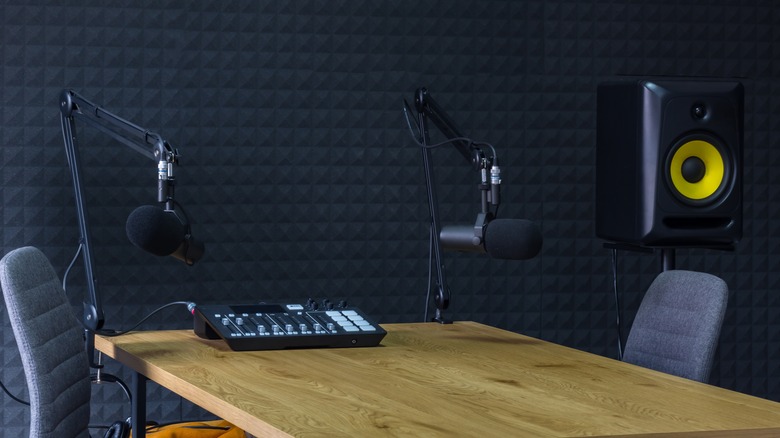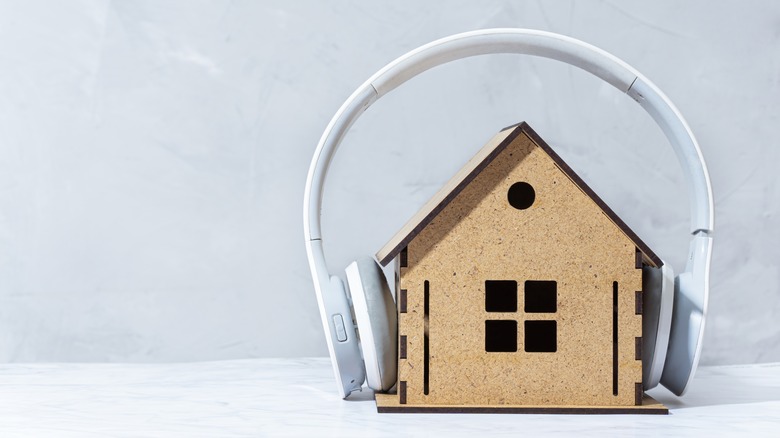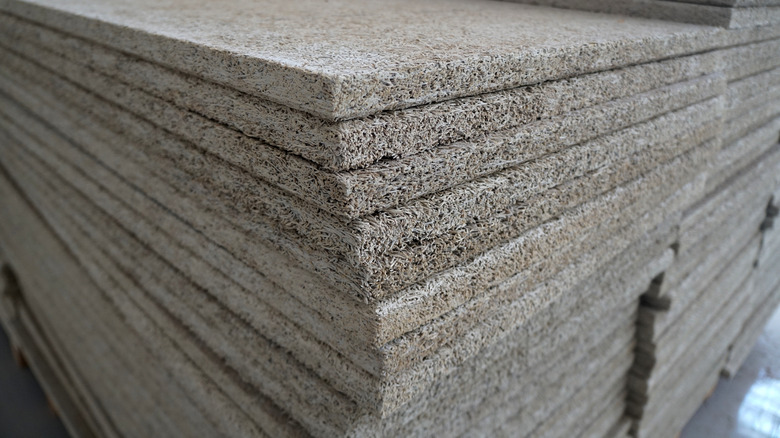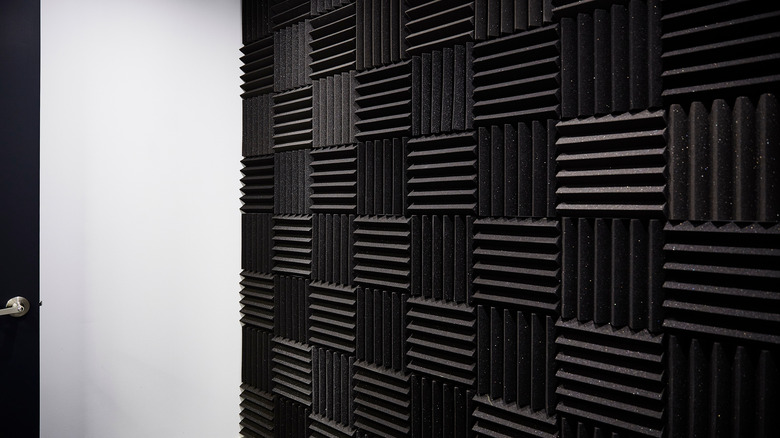The Top 5 Ways To Soundproof Your Ceiling For A Quieter Home
We may receive a commission on purchases made from links.
Soundproofing is a common practice in modern homes. Whether you live in an attached property that abuts surrounding homeowners' spaces or call a totally detached property your home, the need to separate sources of noise and reduce their crossover between rooms and spaces inside the house is essential to maintaining a comfortable living space. This is crucial for segmented spaces within your property and perhaps even more important when considering noise production from neighbors (no one likes hearing their neighbor's TV, music, or conversations!).
Fortunately, there are many great ways to soundproof or dramatically reduce the transference of sound through all kinds of surfaces that exist within the home, including the ceiling, says Soundproof Central.
The primary means of soundproofing involves absorption, dampening, and decoupling, according to Soundproof Central. These approaches, when used in a combination that makes sense for your particular property, can make a huge difference in the amount of sound that transmits through walls and ceilings, making for a much more comfortable living space.
The first step to soundproofing is the discovery phase. Understanding how sound is flowing through hard surfaces in your home can give you an understanding of how to defeat this often annoying feature.
Investigate sources and movement of sound through the property
The first step to soundproofing any room or general section of the home is the investigation process. Evaluating the sources of sound and the amount (volume, general frequency range, etc.) that is bleeding through the ceiling and walls will give you a better sense of the necessary approach to follow.
The first point of order is to understand what is producing the sound that you're hoping to reduce in other parts of the home. Musicians often face off against soundproofing needs, points out MasterClass, and their approach may be different from those just looking to change the volume of television noise that bleeds down into the living room from an upstairs bedroom or vice versa.
These varying needs come from the timbre of the sound, typical volume ranges, and more. A bass guitar player or drummer will need to insulate their practice space against the low-end frequencies that produce the signature deep booms of rhythm instruments. A flute player, on the other hand, won't need to worry much about low-end noise production and instead should focus on cutting down high-pitched tones in their soundproofing approach.
At the end of the day, a soundproofing installation is only effective if it targets the specific types of tones, pitches, and volume ranges that are produced in the connected rooms and spaces. Taking time to explore the sources of noise will give you a blueprint for effective sound management.
Add mass for effective natural deadening of sound
Bulking up the size and weight of the walls and ceilings is a tried and true method for dampening the sound that passes through the surfaces. Adding mass to the ceiling can prevent much of the acoustic flow through the medium and, with the right additions, can be a cost-effective and simple solution to the problem at hand.
Soundproof Central notes that drywall is a great source of mass addition when working to reduce the transmission of sound through the ceilings of your home. The heavier and denser the walling components of the room (both the walls and the ceiling, alike), the better they will dissipate sound waves traveling through their surfaces.
Mass additions can be a simple proposition. To augment a drywall ceiling, adding an extra layer might be the only thing needed to complete the job. For mass additions, speaking with a professional can help you make the right call on where to add material and the type of augmentations to the weight and thickness that will perform the best over the long term. As well, there may be a need to consider the structural integrity of the ceiling if you are increasing the mass of the structure substantially. This might require the expertise of an architect or engineer to ensure that your installation is done safely and that the material will remain in place for as long as you need it there.
Use damping techniques to mute vibrations
Sound damping is a practical approach to defeating excessive vibration through hard surfaces in the home. Damping practices require the use of a damping compound of some type to soak up vibration and further reduce the transmission of sound through walls, ceilings, and other surfaces. Adorama reports that acoustical caulk glue is the best option on the market for damping noise produced in the target room of the house. Damping is specifically useful for reducing (and hopefully eliminating) bass vibrations. These are some of the most intense waves that travel through surfaces, and this results in a greater ability to hear low-end frequencies from across the home, even if you can't perceive the higher-pitched tones.
Damping is a fairly straightforward approach and typically involves the use of these caulking agents to fill in gaps around doorways, above the ceiling in the rafters, and around windows, vents, and other seams. Climbing up into the attic with your acoustical calk glue will give you the best vantage point to apply this essential sealant, coating every point of escape for the sound that emanates from the room below.
Absorption tactics soak up the sound
Approaching sound augmentation through the use of absorption techniques can provide a different kind of effective soundproofing. Instead of trying to minimize sound waves after they've entered the hard surfaces of the room, you can opt to absorb some of the frequencies right in the room. Popular Mechanics notes that sound-absorbing blankets and panels make for excellent additions to a room that requires sound treatment.
Heavy sound-absorbing blankets are full of miniature ruffles and ridges that trap sound waves as they travel around the room. This produces a clearer tone in the space in many instances, as well as a natural resistance to the transmission of sound waves out of the space they are emanating from.
Soundproofing with absorption techniques is perhaps easier than most other approaches because this type of soundproofing doesn't require work that might fall into the category of renovation. Rather than bulking up a wall or crawling around the attic to seal off small gaps in the construction, sound-absorbing materials can be placed within the room and require just the installation of hooks or other devices that can keep the paneling, blankets, or other material in place. These absorption devices can be hung up around a room, creating a layer of soundproofing that extends in all directions from the source.
Creating space between layers dramatically reduces sound
Crafting a buffer in the spaces between rooms or floors is another highly effective way to soundproof a room. Soundproof Central reports that decoupling or segmenting layers of material in the ceiling can prove itself a fantastic means of soundproofing the space beneath. This is something that can be tricky in some homes, though. A suspended ceiling (or drop ceiling) provides a natural decoupling of material elements in the existing construction, but this format for roofing leaves parts of the home's systems in contact with the ceiling, allowing for a smooth transmission of soundwaves out of the target area. Soundproof Central also notes that because of the nature of this type of ceiling, insulation elements here are often lacking in their soundproofing capacity because this addition to the attic space needs to be lighter than the typical insulation material.
Decoupling the ceiling elements gives this overhead space the empty area that it needs to allow sound waves to naturally fall away. Sound waves travel through the air, of course, but when it comes to creating a soundproof space, the focus is on creating physical objects that repel the continuous motion of sound. Adding empty space here performs this function by moving the secondary elements (that sound will continue to resonate through) out of contact with the ceiling.





